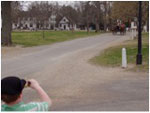BROWSE BY CATEGORY
- Archives and Libraries
- Blogs and Networking
- Bookmark This
- Digital Tools
- Examples of Teaching
- Exhibits
- Film Reviews
- History and Headlines
- Historic Sites and Museums
- Historical Thinking
- Holidays and Heritage
- Issues and Research
- Lesson Plans
- Material and Visual Culture
- Multimedia
- Organizations and Agencies
- Primary Sources
- Professional Development
- Publications
- Student Activities
- Teaching Materials
- Websites
Mark Smith on Nonverbal Williamsburg
 ,
, 
Taking a special needs child outside the school is sometimes a difficult prospect. CBIs, or Community Based Initiatives, get children out of the classroom and into society. This lets them build their social skills and have experiences some might not otherwise get.
Beyond CBIs, which many times are functional in nature (like trips to the store), taking these highly impacted kids on more scholastic-oriented field trips is valuable for them and their general education peers.
I recently took a nonverbal autistic fourth grader to Williamsburg. By “nonverbal” I’m referring to a student with little or no receptive language, as well as little or no expressive language. It’s difficult to communicate the concepts of history to such a student. Background knowledge is limited to popular sources like Disney’s Pocahontas and experiences like visiting Williamsburg. Although I understand there are historical accuracy problems with popular sources (as many of the articles in Teachinghistory.org point out) and I agree with those assertions, with such a nonverbal student those popular sources can be used, in spite of flaws that make them harder to use in other ways or with other students.
Here are a few tips that work with nonverbal students:
- Videos for Prior Knowledge: I used familiar videos prior to making the trip to provide background knowledge. We watched Disney's Pocahontas and Ben and Me and the BBC's version of Beatrix Potter's Tailor of Gloucester. Although my 4th-grade student had watched these movies many (hundreds) of times, we went through them and I pointed out the architecture, such as the houses used by the Powhatans, and tried to visually bring the elements out from the story that we might be seeing on the trip to Williamsburg/Jamestown and Yorktown.
- Songs to Trigger Background Knowledge: The musicals allowed me to sing a few stanzas of songs which triggered the visuals matching where we were. A song from Disney’s Pocahontas used in the Native American village at Jamestown worked to link prior knowledge about life in an Native American village the student learned from Pocahontas together with what they were seeing. The sailing song from Disney's Peter Pan worked the same magic while on board ship.
- Use "Set-Up Shots": In television and cinema, scenes start with set-up shots. A set-up shot is one view that encompasses as much of the story as possible. The great director Cecil B. Demille was a master of the set-up shot. His movie The Ten Commandments starts with a wide panoramic shot of thousands of slaves toiling as they built the pyramids. For a news story the set-up shot might be two leaders shaking hands as the first shot in a story about a new treaty. Using the concept of a set-up shot to help a nonverbal child experience something like Williamsburg is important to provide context. It’s simple, really. When walking up to the three ships docked, I stopped 100 yards out, I focused the child’s attention on the three ships and drew in any prior knowledge I could. I pointed out the details from afar. Then we went and did the hands-on/close quarters stuff. Without a set-up shot, many times these kids don't really get where they are until they are leaving—then they see it all from a distance and "get it." I do this first and last.
- Break Away: If you are on a long class guided tour, and you are in charge of just one or two exceptional students, break away as much as possible. Whenever too much language is being used, split. Walk ahead to the fun stuff (guns, cannons, and boats, in this case) because the folks waiting for the tour will be glad to talk to you. Then when the class catches up, you get to see fun stuff again and because you were there early, they might let your student do more. They let my little guy hold the musket and sword. They were going to have him be part of the crew that shot the cannon, but we had to run and catch the bus.
- Compare Videos with Pictures Taken Onsite: I showed the videos I used for building prior knowledge, and compared them with the pictures taken while on the trip. This made the connections between the experience and prior learning.

The obvious rules apply if you use these tips. Get them plenty of sleep. Take a backpack full of anything you might need. Structure as low a ratio of exceptional students per teacher/IA as possible.
It's a great thing when it works well. And when it doesn't, it still is a great thing.
For more information
You don't have to use professionally-created videos and films to help students learn! In his blog entry on constructivist video, Mark Smith says let students learn by creating and sharing their own videos.
Digital tools are opening up new possibilities for students of all kinds. In our Roundtable, we ask, "Digital textbooks: Has their time come?" Six teachers, publishers, writers, and more share their answers, including educational technologist Jennifer Courduff. "The inclusive nature of digital textbooks has the potential to powerfully meet the diverse learning needs of students who are exceptional," says Courduff in her answer.
David Peal, a history teacher at a school that serves autistic students and others with complex language and learning disabilities, recommends digital e-reading tools and Museum Box, an online tool for creating curated mini-exhibits.
Browse Tech for Teachers to discover more tech tools with diverse classroom applications.
